Group I mGluR activation enhances Ca(2+)-dependent nonselective cation currents and rhythmic bursting in main olfactory bulb external tufted cells
- PMID: 19776280
- PMCID: PMC3837548
- DOI: 10.1523/JNEUROSCI.0206-09.2009
Group I mGluR activation enhances Ca(2+)-dependent nonselective cation currents and rhythmic bursting in main olfactory bulb external tufted cells
Abstract
In the main olfactory bulb, activation of group I metabotropic glutamate receptors (mGluRs) by olfactory nerve stimulation generates slow (2 Hz) oscillations near the basal respiratory frequency. These oscillations arise in the glomerular layer and may be generated, in part, by the intrinsic neurons, the juxtaglomerular neurons. We investigated the physiological effects of group I mGluR agonists on one population of juxtaglomerular neurons, external tufted (ET) cells, which rhythmically burst at respiratory frequencies and synchronize the intraglomerular network. Electrophysiological studies in rat main olfactory bulb slices demonstrated that the mGluR agonist 3,4-dihydroxyphenylglycine (DHPG) amplified the strength of ET cell spike bursts, principally by increasing the number of spikes per burst. Voltage-clamp and Ca(2+)-imaging studies showed that DHPG elicits a Ca(2+)-dependent nonselective cation current (I(CAN)) in the dendrites of ET cells triggered by Ca(2+) release from internal stores. The DHPG effects on bursting and membrane current were attenuated by flufenamic acid and SKF96365, agents known to antagonize I(CAN) in a variety of neurons. DHPG also elicited slow membrane current oscillations and spikelets in ET cells when synaptic transmission and intrinsic membrane channels were inoperative. These findings indicate that DHPG may passively (by increasing burst strength) or actively (by increasing conductance of gap junctions) enhance the strength of electrical synapses between ET cells. Together, these findings indicate that activation of group I mGluRs on the dendrites of ET cells play a key role in the generation of slow rhythmic oscillation in the glomerular network, which is in turn tuned to sniffing of the animal in vivo.
Figures
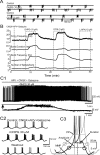
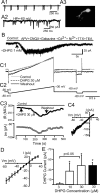

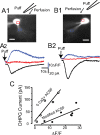
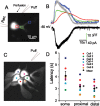
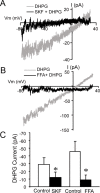
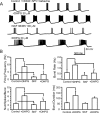

Similar articles
-
Activation of group I metabotropic glutamate receptors enhances persistent sodium current and rhythmic bursting in main olfactory bulb external tufted cells.J Neurophysiol. 2014 Feb;111(3):641-7. doi: 10.1152/jn.00696.2013. Epub 2013 Nov 13. J Neurophysiol. 2014. PMID: 24225539 Free PMC article.
-
Olfactory bulb glomeruli: external tufted cells intrinsically burst at theta frequency and are entrained by patterned olfactory input.J Neurosci. 2004 Feb 4;24(5):1190-9. doi: 10.1523/JNEUROSCI.4714-03.2004. J Neurosci. 2004. PMID: 14762137 Free PMC article.
-
Metabotropic glutamate receptors in the main olfactory bulb drive granule cell-mediated inhibition.J Neurophysiol. 2007 Jan;97(1):858-70. doi: 10.1152/jn.00884.2006. Epub 2006 Nov 8. J Neurophysiol. 2007. PMID: 17093122 Free PMC article.
-
Novel modes of rhythmic burst firing at cognitively-relevant frequencies in thalamocortical neurons.Brain Res. 2008 Oct 15;1235:12-20. doi: 10.1016/j.brainres.2008.06.029. Epub 2008 Jun 19. Brain Res. 2008. PMID: 18602904 Free PMC article. Review.
-
A proposed role for electrical coupling in the neocortical slow oscillation.Rev Neurosci. 2025 May 7. doi: 10.1515/revneuro-2025-0018. Online ahead of print. Rev Neurosci. 2025. PMID: 40366628 Review.
Cited by
-
The influence of single bursts versus single spikes at excitatory dendrodendritic synapses.Eur J Neurosci. 2012 Feb;35(3):389-401. doi: 10.1111/j.1460-9568.2011.07978.x. Epub 2012 Jan 25. Eur J Neurosci. 2012. PMID: 22277089 Free PMC article.
-
Participation of a persistent sodium current and calcium-activated nonspecific cationic current to burst generation in trigeminal principal sensory neurons.J Neurophysiol. 2013 Oct;110(8):1903-14. doi: 10.1152/jn.00410.2013. Epub 2013 Jul 24. J Neurophysiol. 2013. PMID: 23883859 Free PMC article.
-
Coherent olfactory bulb gamma oscillations arise from coupling independent columnar oscillators.J Neurophysiol. 2024 Mar 1;131(3):492-508. doi: 10.1152/jn.00361.2023. Epub 2024 Jan 24. J Neurophysiol. 2024. PMID: 38264784 Free PMC article.
-
Glucose sensitivity of mouse olfactory bulb neurons is conveyed by a voltage-gated potassium channel.J Physiol. 2013 May 15;591(10):2541-61. doi: 10.1113/jphysiol.2013.254086. Epub 2013 Mar 11. J Physiol. 2013. PMID: 23478133 Free PMC article.
-
Activation of Group II Metabotropic Glutamate Receptors Suppresses Excitability of Mouse Main Olfactory Bulb External Tufted and Mitral Cells.Front Cell Neurosci. 2018 Jan 17;11:436. doi: 10.3389/fncel.2017.00436. eCollection 2017. Front Cell Neurosci. 2018. PMID: 29386998 Free PMC article.
References
-
- Anwyl R. Metabotropic glutamate receptors: electrophysiological properties and role in plasticity. Brain Res Rev. 1999;29:83–120. - PubMed
-
- Beierlein M, Gibson JR, Connors BW. A network of electrically coupled interneurons drives synchronized inhibition in neocortex. Nat Neurosci. 2000;3:904–910. - PubMed
-
- Buonviso N, Amat C, Litaudon P. Respiratory modulation of olfactory neurons in the rodent brain. Chem Senses. 2006;31:145–154. - PubMed
Publication types
MeSH terms
Substances
Grants and funding
LinkOut - more resources
Full Text Sources
Miscellaneous
